A high voltage buzz crackled through the air as two diminutive fays sizzled on the wing, like demented dragons, just a few inches above my head. A shrill battle cry sounded from the whirl of wings, beaks and tiny claws. In a second it was over, and the victor returned to his throne to scrutinize his kingdom in preparation for the next skirmish.
I was back in California, and once again found myself in the San Francisco Botanic Gardens. Why? To try for a photograph of the dazzling Anna’s Hummingbird, of course. Anna’s Hummingbird was the first hummer that I saw when I came to the United States. I remember the moment that a little moss green bird transformed itself in front of my eyes, with a split-second flash of metallic pink blaze. It was a breathtaking sight and a moment of beauty that I wanted to capture in a photograph. The bird is beautiful at all times, but the blaze, that only shows when struck by sunlight at the perfect angle, takes it to a new level. Without sunlight this hummingbird’s face has a black or charcoal grey appearance. Add a few droplets of sun and magic occurs.
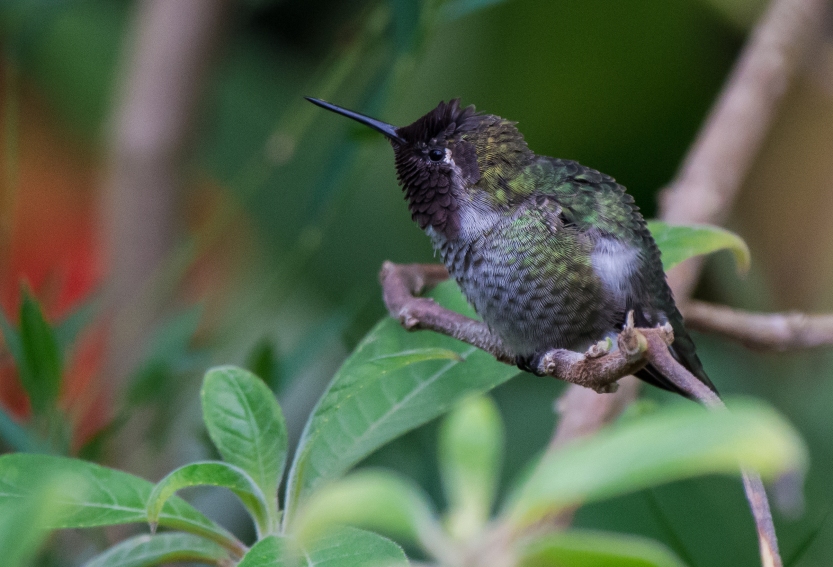
It seems that every time I try to photograph hummers it is under grey skies and drizzle. This means that I’m constantly battling with the camera to get a fast enough shutter speed to capture these glittering speedsters. This day was no different, as a misty rain was either falling or trying to fall all day. But on this day Anna’s hummingbird was out in abundance. In previous visits to the Gardens the constantly angry Anna’s was too high, too fast, too feisty or just not around. It was the molting season, so some of the birds were not at their very best, but still offered a stunning spectacle. With a rain jacket, hat and a lot of patience, I was able to find and photograph a few fine specimens.
I walked the paths of the drizzly Gardens, firing off some shots as an occasional hummer buzzed into range. I got a couple of nice shots of malignant males on their perch, guarding their territory like minuscule iridescent rottweilers with wings. As I walked on I was seeing hummingbirds everywhere. I snapped a few females and young males, but I wasn’t getting any closer to capturing the pink blaze. A young male gave me a glimpse of a pink throat as it zipped between tiny lilac heads of sage.
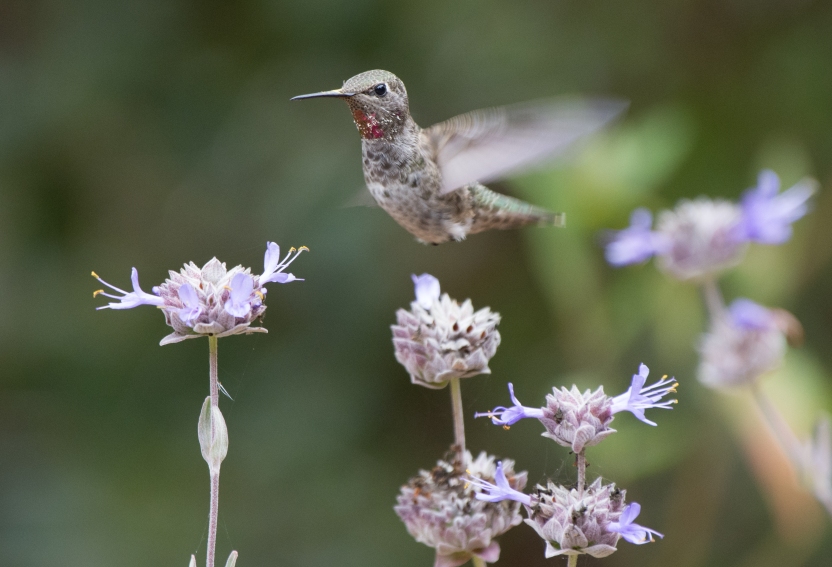
I set my shutter speed as low as I could as I wanted to capture the blurred wingbeat. This is my way of remembering extraordinary speed and energy as well as the hum as the bird zips from flower to flower. Perhaps the attraction of these birds is how they stimulate our senses. The vivid colours, the vibratory hum of the wings, the scent of the oozing flowers that are almost an extension of the bird itself. It isn’t at all clear whether the flower was designed for the bird or the bird for the flower. Perhaps they are part of the same thing but sometimes separated by air.
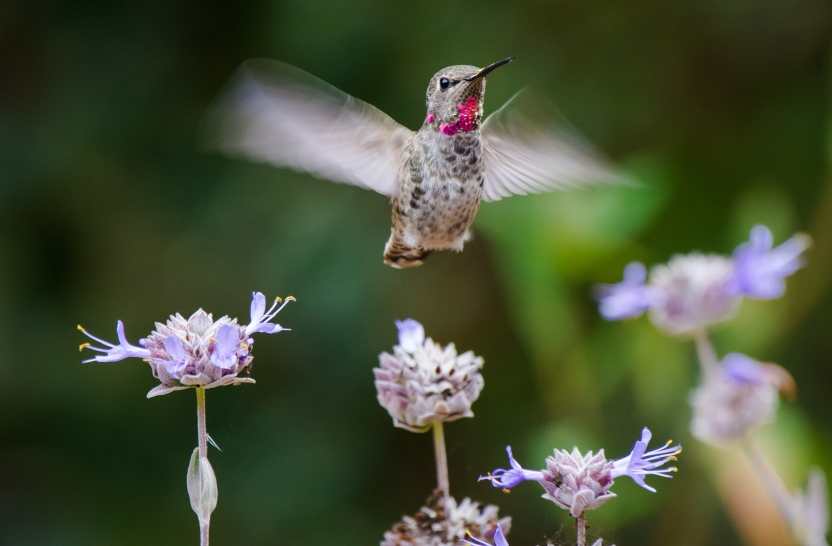
Anna’s Hummingbird, like all hummers, is as small as it is beautiful. A full grown adult bird does not exceed 10 cm (4 inches) in length and the lightning fast wings span only 12 cm (4.7 inches). 100 years ago, this common hummer of the West Coast lived only in northern Baja California and southern part of California. As humans developed a taste for exotic plant species in our parks and gardens, Anna’s hummingbird spread north following the gardening trend. They can now be found as far north as the southern end of British Columbia.
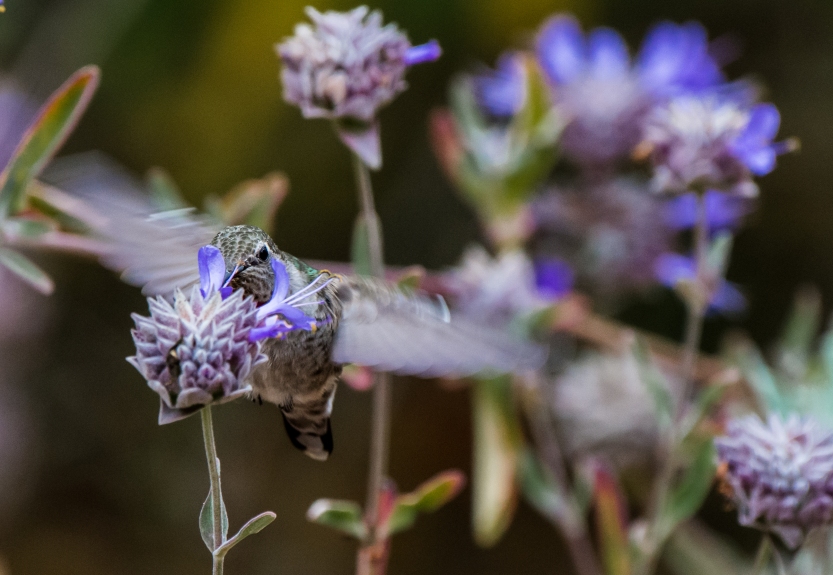
So, who is the Anna after whom this vibrant little bird was named? Part of French society in the 1800s, Anna of Belle Massena, Duchess of Rivoli, Princess of Essling was the wife of Prince François Messena, a nobleman with a keen interest in birds and a friend of John James Audubon.
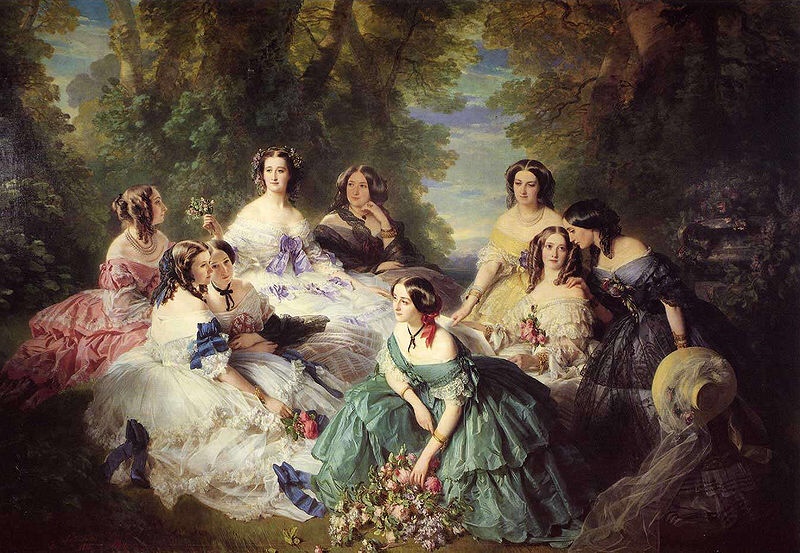
The Prince kept a collection of stuffed birds, including many thus far unidentified birds. One of these unidentified birds was a tiny hummingbird from Baja California. Rene P. Lesson, a French naturalist, named the hummingbird in the collection after Anna.
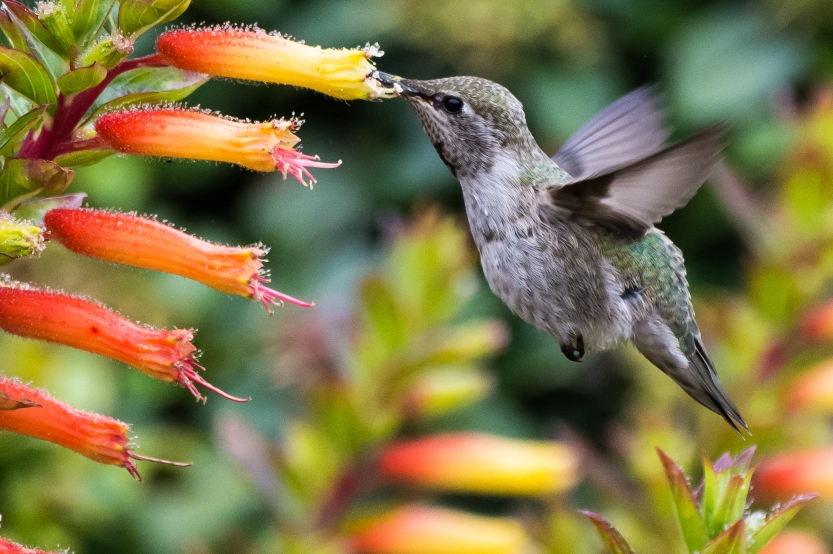
I continued walking the Garden trails and snapped several metallic sprites supping nectar from wax drop flower heads. The day was drawing to a close and the light was getting too low to work in the darker areas of the Garden. I knew that there was an open area with some low flowering plants that might give me the best chance of working with the last of the light. I had seen hummingbirds in this area close to the entrance of the Gardens when I arrived, so I headed over to see what I could find.
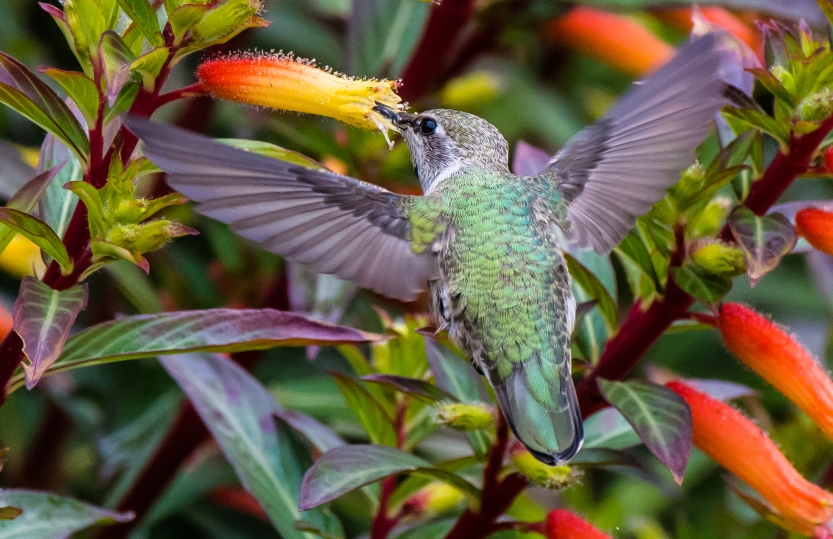
As I approached I could hear the high-pitched twitter of an Anna’s. I sat on a low wall and aimed my lens at a cluster of flowers. I sat so still and quiet that a Scrub jay buried an acorn beside me. A hummer zoomed into view and I machine gunned a few shots. The drizzle continued but the sky brightened a little. The photos were usable, so I got comfortable, deciding to finish the day in this spot. An adult male buzzed the area and was soon in aerial combat with an adversary. These attacks are always way too fast for me to put in to pixels. The two fighters vanished, and a moment of silence fell over the flower patch. At that moment a single shard of sunlight punctured the clouds, spotlighting the flower patch. I adjusted the camera and lifted the lens as a hummer flashed into the view finder. An adult male hovered in the beam of light as it scanned the flowery pick-n-mix. As I pressed the shutter release he presented a gift to me; a reward for my patience. My viewfinder fluoresced with pyrotechnic pink as the stabbing blade of sunlight ignited Anna’s hummingbird’s blaze. As fast as he appeared, like rose lightening he was gone. I looked at the couple of shots I had captured as the shard of sunlight faded in the closing clouds. I switched off the camera and set off for my hotel. I had been given enough.

A few weeks later I was on vacation, driving along Big Sur. I stopped to get a scenery shot of the magnificent Pacific coastline. As I walked back to the car I heard a familiar sound. There was a young Anna’s Hummingbird on a perch, surveying his territory. I could not resist a lens switch for a shot of his surly face, with pollen speckled beak against a terracotta backdrop.
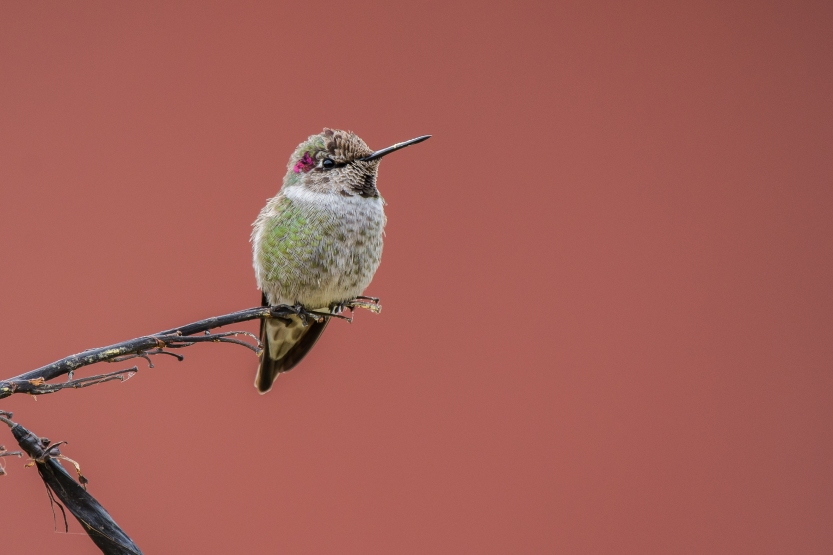
Like a moth to the flame, I know I’ll be drawn back to the Botanic Gardens and the pink flare of Anna’s Hummingbird the next time I am in San Francisco. Camera or no camera there is something special about being in the presence of this remarkable little angry bird.
Followers of this blog will know that Hummingbirds are a favourite bird of mine. My first ever Incidental Naturalist blog post was San Francisco; Hummingbirds in the City and I’ve written about the jewels of the air in Panama in Coffee With Hummingbirds.
Join the conversation below. Have you seen hummingbirds? What is your experience of the feisty Anna’s Hummingbird? 👇👇👇
If you like this post please give it a Tweet or share it on Facebook or whatever your platform of choice may be. Also, follow Incidental Naturalist through WordPress or via email. No spam zone!
Categories: USA
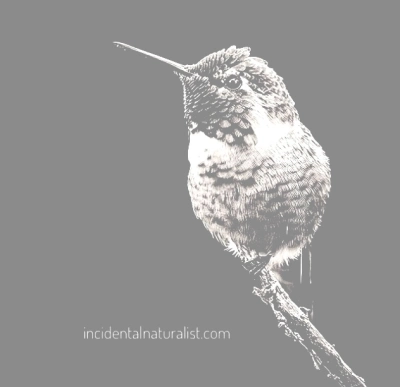


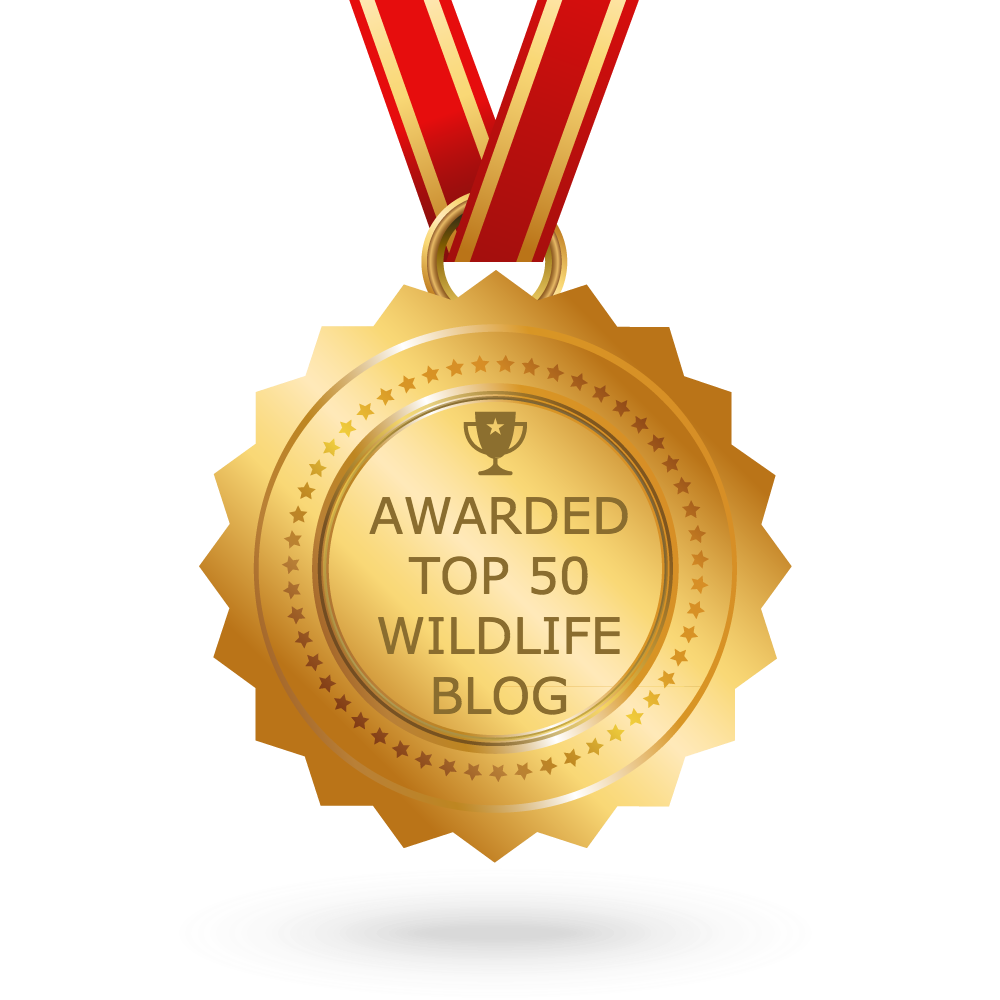

Beautiful photos! Just love hummingbirds and how they will get used to having you around them.
LikeLiked by 6 people
Thank you, Linda! It is amazing how close you can get to hummingbirds. I don’t think they realise that they are small. In their minds they are flying tigers! 🙂
LikeLiked by 3 people
nice photo
LikeLiked by 1 person
Thank you! 🙏
LikeLiked by 1 person
Beautiful story and photos! I have never seen an Anna’s hummingbird but have some experience with Rufous and Calliope as they are most common in Alberta. I love watching and photographing them 🙂
LikeLiked by 6 people
Thank you, Kerri! They are amazing little birds aren’t they. I have seen the Rufous in San Francisco, but I need to get better photos. I’m yet to see the Calliope but it is on my list!
LikeLiked by 1 person
They are the most exquisite creatures! Am so amazed at that hue of pyrotechnic pink – such flamboyance. Coming from the eastern hemisphere, we have our little sunbirds but i was really lucky to spend time in Trinidad, Asa Wright especially sipping coffee on the hummingbird deck. What an incredible display of these extraordinary aerialists. And once i came across a couple of photographers staked out over some red Chaconia flowers up Tucker Valley, we hike up the mountain and back and 4 hours later they were still there waiting with bated breath for a treasured shot of a scarlet coquette 🙂
LikeLiked by 5 people
That is fantastic! Photographing hummingbirds is definitely work for patient people. It is hard enough to do in a botanic gardens with a large hummer population. I can’t imagine how hard it must be out in the wild when looking for one rare specimen. I guess you must put all your bets on one flower and hope that the bird and the light cooperate. 🙂
LikeLiked by 2 people
Wow, these photos are amazing!! I had good fun trying to get photos of hummingbirds in Costa Rica. So I know how tricky it is to capture them when they are on the move. I am very impressed.
LikeLiked by 4 people
Thank you! I think some of my best hummingbird photos were taken in Panama, albeit in the rain. I hope to get to Costa Rica some day to try for them there. The trick is to find the sweetest flower. 🙂
LikeLike
I used to love watching Anna’s hummingbirds when I lived in California. They’re just so full of energy and rage; which, coupled with their small size and dazzling beauty, always makes me smile.
LikeLiked by 3 people
Hi Josh! “full of energy and rage” Perfect description of these tiny terriers. How can they be so angry all the time! 🙂
LikeLiked by 1 person
Haha, I have no idea where all their anger comes from! But I’ve even seen tiny Anna’s chasing Cooper’s hawks!
LikeLiked by 1 person
Yep, me too. Hawks, anything! If they were bigger then we would all be in trouble!
LikeLiked by 1 person
We certainly would!
LikeLiked by 1 person
Oh I so admire your patience! But I can see how it rewards you. All the shots are great – really evocative of their fragility and speed, but the one that captured the ruby head it truly fabulous.
I know I don’t really have the equipment to capture hummers, but more important than that I don’t have the patience.
Alison
LikeLiked by 5 people
Thank you, Alison! 🙏 I have the attention span of a mosquito for most things in life. I seem to be able to nudge that up to goldfish levels when there are hummingbirds around. The hummingbird’s beauty is a gift to a photographer, but they don’t give up those throat flashes without a fight. 😊
LikeLiked by 1 person
I always love your shots interspersed in your writing. It’s a perfect mix. I also totally agree with the “rottweilers with wings” observation! It sure does seem to sum them up. I saw these guys when I lived in Washington state.
LikeLiked by 4 people
Thank you, Tara! 🙏 Wow, you have lived in some fantastic places. The places on my list!
LikeLiked by 1 person
Nice! I have barely visited anywhere in this world. (And I’m okay with that.) I have, at times lived in Washington and Idaho and of course mostly Alaska. I’ve seen a few other states. But I don’t have that itch to travel.
LikeLiked by 1 person
Just as well. If you ever do and you ever scratch that itch then you just can’t stop! 😁
LikeLiked by 1 person
I will live through you and your travels! Your photography and your storytelling is perfect.
LikeLiked by 1 person
Well done, beautiful photos. Definitely worth the perseverance and thanks for sharing.
LikeLiked by 3 people
Thanks for the kind words, Anna! 🙏😊
LikeLike
Your narratives integrate nature, photography, history and geography seamlessly. Thank you for making me want to go out and write about what’s captured.
LikeLiked by 4 people
That is very kind of you to say that. Thank you! 🙏 😊
LikeLike
Nice, wants to learn more
LikeLiked by 3 people
I’ve never seen hummingbirds unfortunately, but I’d love too! Such tiny little warriors.
LikeLiked by 4 people
I can’t get enough of them! I’m hypnotized by them. I only saw my first one a few years ago.
LikeLiked by 1 person
Love these birds! Fiesty for sure, brilliant with color, fascinating to watch them fly, dive bomb, and hover. Thanks for another lovely post, David! As always, great shots captured and love the history you add “))
LikeLiked by 4 people
Glad you enjoyed it, Lara! Even though these little thugs are west coast regulars for you. 🧚♂️ Thanks as always for the kind words 🙏😊
LikeLiked by 1 person
Reblogged this on Vijayagiri views.
LikeLiked by 2 people
This hummingbird recently became British Columbia’s provincial bird.
LikeLiked by 3 people
Absolutely magnificent photos. Very well done
LikeLiked by 3 people
Thank so much for the kind words, Paulie 🙏
LikeLiked by 1 person
I spent much of the last 2 Saturdays at the SF Botanical Garden. It’s a beautiful place.
LikeLiked by 1 person
Yes, it is a real oasis. The San Francisco area has so much to offer in term of wildlife. The Botanical Garden can stand up alongside anywhere else in the region as a place to go to enjoy tranquility and nature. The bonus is that it is in the city.
LikeLiked by 1 person
Beautiful photos. As I’m reading this. I can hear birds singing in our garden.
What a lovely sound. Helps us all through the worries and strife of life .
LikeLiked by 4 people
Thank you! 🙏 I agree completely. A little birds song can go a long way. I love in an apartment block and have a robin nest right outside the door. It makes me smile morning and evening on my commute. Nature provides that little bit of joy magic. 😊
LikeLike
The joy which we all need in times of trouble and the 24 hour society. No time to rest. But time to listen to the birds sing and the sound of the trees from the wind blowing.
LikeLiked by 1 person
Your,,good..👌👌👌
LikeLiked by 2 people
Reblogged this on kupukupu neraka and commented:
Is cool,
LikeLiked by 2 people
Splendid work, David. It is so difficult to capture these tiny fluttery fellas. Need a ton of patience. You have captured them so well. All the shots are perfect.
LikeLiked by 3 people
Thank you for the kind and encouraging words, Ranjit. These little guys definitely require some patience but they are worth it when you catch them in the right light.
LikeLike
So true. I tried once. Had a hummingbird feeder with premium nectar in the backyard in CT state. Couple hummers use to visit. Snapped once. Will find them and share. Might not be any near to yours.
LikeLiked by 1 person
Just because I was able to share some decent photos, don’t make the mistake of thinking all my photos were good! 😃 lots of practice and patience gives us a sporting chance.
LikeLike
Agree 😊
LikeLiked by 1 person
Nice photos
LikeLiked by 3 people
Thank you, Alex!
LikeLike
Wonderful pictures!
I think it’s the first time I’ve ever seen a hummingbird at rest in picture .
LikeLiked by 3 people
Thank you! 🙏 Yes, they are not big on resting. I suspect that even though the body was at rest the little mind was preparing for battle 😃
LikeLike
Beautiful photos and stories. 🙂
LikeLiked by 3 people
Thank you for the kind words 🙏
LikeLiked by 1 person
Beautiful photos! Loved this. Amazing little birds. Followed your blog. Do check mine
LikeLiked by 3 people
Thanks for taking the time to leave a kind comment. 🙏
LikeLike
I am lucky enough to have a few hummingbirds that live on my lemons trees. Even though they live in my backyard are still hard to capture a good photo of them. Nice job on getting these captures!
LikeLiked by 3 people
Thank you! Fantastic to have them on your Lemon tree. The trick to getting a photo is to find the flower that is giving nectar. Then wait for the bird to come back to it.
LikeLiked by 1 person
Beautiful photos
LikeLiked by 3 people
Thank you, Robin!
LikeLiked by 1 person
I don’t think I’ve ever seen a hummingbird at rest haha! These are some great photos, and I love the colorful and descriptive narrative behind the photos.
LikeLiked by 3 people
Thank you for the kind words. They do stopping moving for a few seconds a day. 😃
LikeLike
Thank you David for sharing your photography and experience of these humble creatures.
Indeed makes us ponder over creation, so much of the world we haven’t even seen yet
LikeLiked by 3 people
Thanks for visiting and taking the time to leave a comment. These extraordinary birds certainly point to how much of life on earth remains a mystery to us. I believe that we know much less than we think we know. I’m thrilled to receive a comment from a fellow person of Thurrock, even though I am currently living so far away. 😊
LikeLike
Those are the most beautiful captures !
Love hummingbirds –
Feisty
LikeLiked by 3 people
Thank you for the kind words! Feisty indeed! 🧚♂️ 🐉
LikeLiked by 1 person
This was beautifully written! Given the “not best lighting” for that day, the shots came out magnificently. There are some flowers near my house that pop up during early spring, and I always seem to spot a hummingbird shoot past me. Wonderful little creatures aren’t they? ❤
LikeLiked by 3 people
Thank you for the kind comments! Very encourging. They certainly are wonderful little creatures.
LikeLiked by 1 person
Gorgeous images, and I appreciated the well-written context! Mostly ruby-throated and broad-tailed where I live in the Colorado foothills. We had a very late spring snow this year and it was a treat to see a ruby-throated male working the ice-crusted feeder, though my heart went out to the little guy. Given the energy they expend, I imagine they haven’t much of a survival buffer when it comes to unexpected cold and snow.
LikeLiked by 3 people
Thank you, Cate! In those conditions that is when hummers really do benefit from feeders. They can survive but they need to keep feeding and the margins are slim in their energy spend to food intake ratio. Good job on getting them through the cold snap!
LikeLike
Amazing images.
LikeLiked by 2 people
Thanks!
LikeLiked by 1 person
Excellent work mate. I hope I can start a blog like this one
LikeLiked by 3 people
Thank you, Muhammad! I appreciate the kind comment. Good luck on your blogging journey.
LikeLike
I really love these guys and had them also in font of my camera last year in Canada.
LikeLiked by 3 people
If only we could all live our lives as the beautiful and powerful humming bird!
LikeLiked by 3 people
We can! If we choose to ☺️
LikeLiked by 1 person
What fantastic little birds, David. Fantastic shots! We don’t have humingbirds here although some regard our sunbirds as being somewhat similar. 🙂
LikeLiked by 4 people
I’m a huge fan of sunbirds. I regularly tracked down the different species in Asia and encountered the Olive-backed in Queensland. I wish I had been more committed to photography back then. That said, as much as I love them, there is something special about the hummingbirds. 🧚♂️ Hope all is well with you, Jane. It is good to see you finding time to get out in nature and share your walks with us. 😊
LikeLiked by 2 people
Beautiful shots!
LikeLiked by 5 people
Thank you!
LikeLiked by 2 people
These are great images.
I always have difficulty taking photos of birds because I love them too, especially the simple sparrow but I just lose patience.
LikeLiked by 4 people
You need lots of patience with the hummingbirds!! 😁 Thanks for the kind words 🙏
LikeLiked by 2 people
Enjoyed your post. Thank you.
LikeLiked by 3 people
Loving your blog of the hummingbirds. I once had a closeup with a blue hummingbird, but unfortunately did not have my camera ready. These are really appreciative to see. Keep up the good work!
LikeLiked by 3 people
Thanks for the kind comment! 🙏 I feel blessed any time that I see a hummingbird. The camera is just a bonus.
LikeLiked by 1 person
Humming birbs r cute
LikeLiked by 3 people
We were lucky to see few humming birds in U.S. In India we have Sunbirds. Initially I thought Sunbirds are similar to Hummingbirds, but only when I saw them first time I realized they are totally different. Amazing photography of hummingbirds
LikeLiked by 1 person
Thank you so much for visiting my blog and leaving a thoughtful and kind comment. Having lived in Singapore and traveled around the region, I fell in love with Sunbirds. I hope some day to be able to spend time photographing them. Sunbirds and hummingbirds share an iridescent beauty, but the hummingbird combines this beauty with a fierce personality and extraordinary movement.
LikeLike